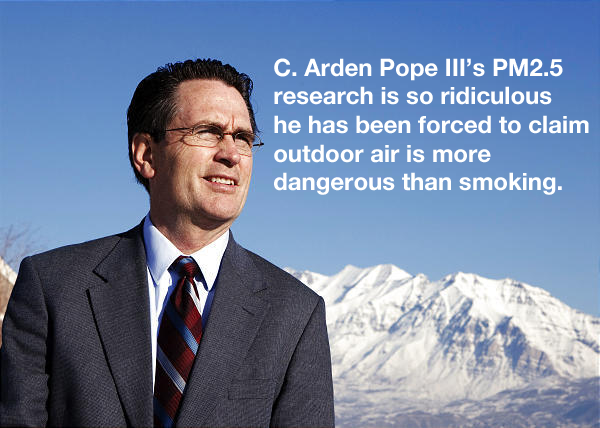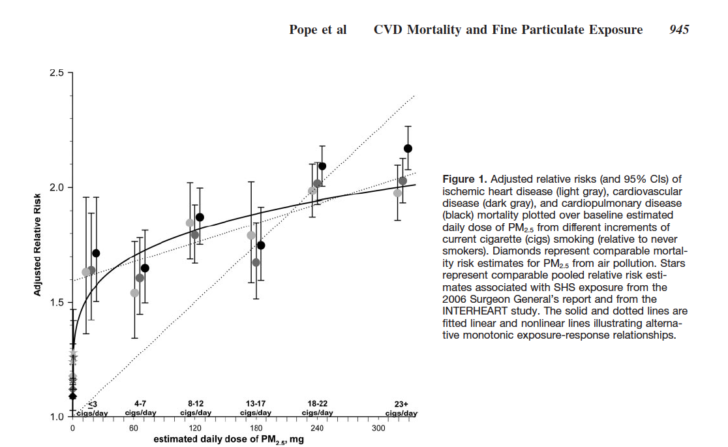That’s how stupid EPA air quality “science” is.

EPA claims that any level of fine particulate matter (soot and dust called “PM2.5“) in outdoor air is is deadly. The problem for EPA, however, is that much higher exposures to PM2.5 from smoking aren’t comparably deadly. So, for example:
- Short-term exposure to PM2.5. A non-smoker breathing average U.S. outdoor will inhale 0.010 milligrams (mg) of PM2.5 per hour. EPA claims that exposure to PM2.5 could kill a non-smoker within hours. Yet a marijuana smoker will inhale 180 mg of PM2.5 from a single joint — i.e., 18,000 times more PM 2.5 in about 15 minutes — without risk of death. In fact, physicians prescribe medical marijuana to sick people and it is not known to kill them.
- Long-term exposure to PM2.5. As previously and pictorially explained, a smoker can inhale an incredible amount of PM2.5 and have the same life expectancy as a non-smoker.
Of course, EPA and its researcher scoundrels know that the EPA’s PM2.5 claims don’t pass the red-face test so they opted to simply declare the contradiction does not exist.
This was done in a 2009 study by EPA-funded “researcher” C. Arden Pope, who tried, for lack of a better description, to “scientificize” an explanation for why outdoor air is deadlier than smoking. Pope’s “explanation” is that PM2.5 is very deadly at low levels (i.e., outdoor air), but the dose-response curve flattens out at higher exposures (i.e., smoking). Below is what Pope claims the PM2.5 dose-response curve looks like.

This graph doesn’t do justice to the disparity in PM2.5 exposures between outdoor air and smoking. The PM2.5 exposures on the far right (i.e., more than a pack of cigarettes per day) are at least 1,000 times higher than the outdoor air exposures on the far left.
Moving past the fundamental science dishonesty of EPA-funded researchers like Pope — keep in mind he has hidden his PM2.5 data from independent scrutiny for 20+ years — Pope’s excuse for the PM2.5 contradiction falls short in two major ways:
- For about 500 years now, a basic principle of toxicology has been, “the dose makes the poison.” A corollary of this is “the greater the dose, the greater the poison.” Pope’s explanation concerning PM2.5 attempts to turn this principle on its head — worse, he attempts to do this with his secret data. Another researcher who tried this con was the University of Missouri’s Frederick vom Saal. With his secret data, vom Saal claimed to show that low levels of bisphenol-A (BPA) disrupted the hormonal systems of mice. This is fraud not science.
- In the improbable event that Pope actually is acting in good faith, then he has merely demonstrated his ignorance of basic epidemiologic principles. The “relative risk” computations of epidemiologic studies are not estimates of actual “risk.” Rather, they are a ratio of observed incidence rates in studied populations and are used as measures of the “strength of association” between exposure of interest and disease of interest. The strength of association is then only one factor in considering whether a cause-and-effect relationship exists. For example, actual epidemiologists (unlike Pope, whose PhD is in agronomy) doubt even whether smoking by itself is linked with heart disease. This, for one reason, is because the strength of association in smoking-heart disease epidemiology studies is not very impressive (i.e, relative risks on the order of 2.0). So Pope has misrepresented strengths of association as risk estimates which he then improperly lays side-by-side for comparison purposes. Assuming for the sake of argument that Pope’s PM2.5 relative risks for outdoor air were legitimately calculated (a HUGE assumption), they are so tiny (about 1/10th of the disputed relative risk for smoking and heart disease) so as to be that much more dubious than those for smoking-heart disease. That is, as measures of strength of association, they exhibit no strength at all.
The reality is PM2.5 in outdoor air kills no one. But EPA’s regulatory agenda has compelled folks like Pope to contort “reality” to fit this agenda — and then dare the public to challenge it.
Hans Christian Anderson wrote this story long ago:

Some people seem to believe that they are going to get out of this life alive. When a climatite tells me how much longer will live, I tell him how long he’s going to be dead. Nobody likes me anymore.
Good idea, stan b!!!
Besides, everyone knows you’ll positively get cancer from smoking in 20 years or so, so you’ll have an that additional 20 years (or more!) added to your lifetime!!
After that, you can take up heroin. I hear a man can live for decades addicted to the crap. Hell, you could double your effective lifetime!
Personally, if I get to 90 years old I’m going to take up smoking. Studies of mortality show that people over 90 who smoke have lower mortality than those over 90 who don’t smoke.
Interpretation: Hold your breath, your air tax cometh.
By “smoking” do they mean pot?
Yes, yes!
That is why rural residents in farming communities seem to have a greater incidence of…wait, they don’t have a greater incidence of respiratory problems, do they.
All that dust, and pollen, and other allergens along with exhaust form farm equipment!
Guess I’ll have a smoke but stay in to save my life WOW ! criminal science !